
Asia is known for its exotic travel destinations. Visitors come to this side of the world for historical sites, beautiful beaches, awe-inspiring architecture and townscape, food, and many other activities. However, apart from occasional fruit snacks served in some street markets, many tourists will not really have tasted all the Asian fruits this continent offers. So, today, we are sharing with you some fruit tastes you must try when you visit or revisit Asia
Over 30 Exotic Fruits From Asia that you Must Try
Here you will find everything from the Banana and the smelly Durian to the Wood Apple and the Yuzu! They are all exotic and only a few are well known in the West. Are you ready to discover these fruits? Then read this guide till the end. If I have missed any please let me know. In case you came here to look something up, I have put them in Alphabetical Order.
Asian Fruits in Alphabetical Order
A – Asian Pear
Asian Pear grows mostly in East Asia. Its flowers are considered as a symbol of Spring. In different countries, Asian pear has different names: Japanese Pear, Chinese Pear or Korean Pear. Asian pears are quite expensive and in the greengrocery stores, you can always find them in a foam net as they bruise easily.
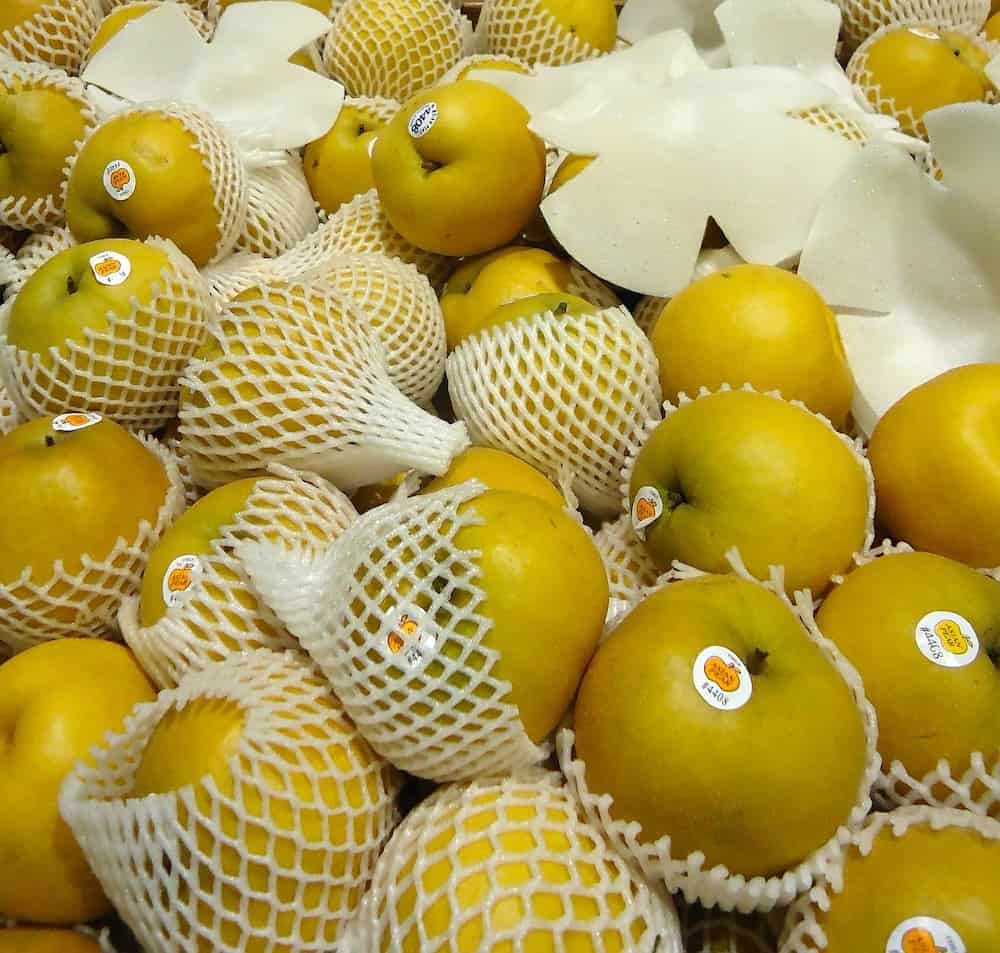
What is the difference between an Asian pear and a regular pear?
The Asian pears look more like big yellow apples with rough skin. They have a texture more like apples but at that same time, they are juicy like pears.
B – Banana
Let’s start with the banana, not only because it tops the Asian Fruit alphabet but because it is the most commonly eaten fruit in the world. Bananas can be found in every size from the tiny sweet thin-skinned variety from Salalah in Oman to the enormous fairly hard shinned varieties we have found in markets in Central America. You can also find pink and red bananas in India.
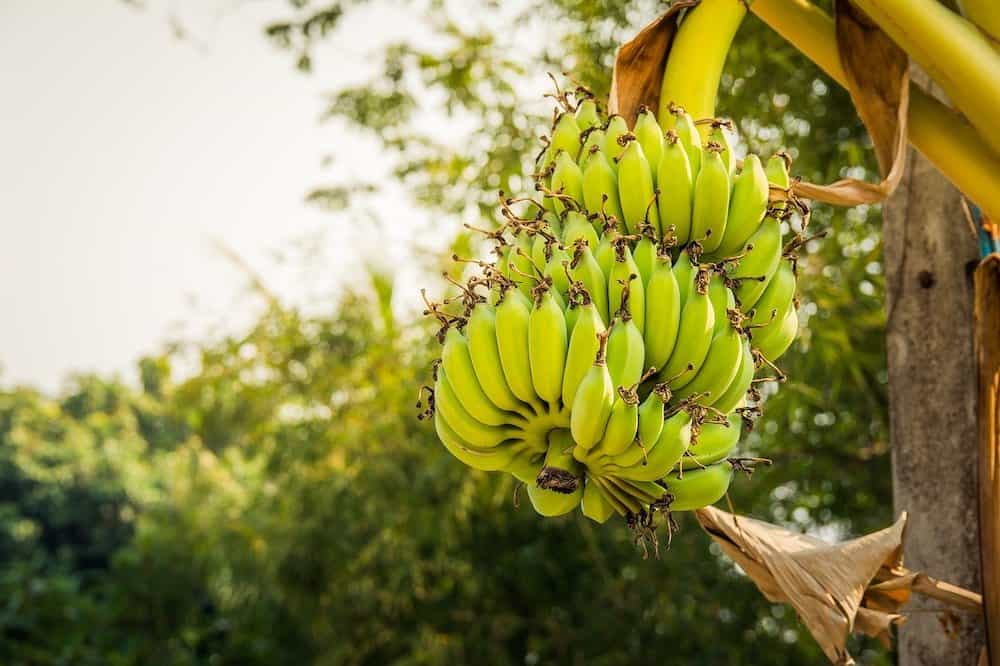
By far the commonest bananas worldwide are all from the single Cavendish variety. This variety is so dominant that experts fear the inevitable rise of some specific pest, and the impact it will cause on the vast banana market.
While in Indonesia, try banana fritters made from Pisang Raja banana aka Musa Belle. Some varieties of Bananas are like plantains and used only for cooking – don’t try these ones raw unless you like the flavor of raw potatoes!
C – Coconut
Coconuts are another common fruit. They grow in palm trees, particularly in tropical regions. Palm trees don’t have branches and so the fruit grow at the top of a tall trunk just under the fronds, so it can be hard to harvest coconuts.
These fruits are known for their diverse uses including traditional uses in Asian cuisine as well as cosmetics. Coconuts contain a sweet flavoured fluid known as coconut water, especially when they are immature. Our girls learned and loved drinking coconut water when we were exploring Bangkok with kids.
By the time coconuts reach western shops they are usually dry brown and hairy when their delicious hard white flesh is the main attraction. Often in their own countries coconuts are consumed much earlier, with the green husk still in place. At this early stage of ripeness, the flesh is immature and they are cut just so that the fluid inside can be drunk using a straw.

D – Dates
Another Palm fruit, Dates grow in clusters hanging from the top of the palm trunk. Date palms are shorter, broader trees than the tall leaning coconut palms seen on tropical beaches.
Dates originate from south west Asia, the area we know as the Middle East, where entire sections of supermarkets will be dedicated to different varieties. Here you can find dates from various countries and at different stages of ripeness from crisp pale young fruit to the sweet dark sticky overripe types we normally see in the West. For the real connoisseur, you will even find them stuffed with almonds or coated in chocolate. Our favourite dates come from small village Misfat al Abriyeen

Dates were and are as much a part of Arabic culture as the Caribou was to the Eskimos. Arabic fortresses surviving from the times of the Crusades have rooms dedicated to the pressing of sacksfull of ripe fruit. The oil was collected, heated up and poured boiling from the battlements onto the heads of any unfortunate attackers.
D – Dragon fruit
The Pitaya (Pithaya) or Dragon fruit is perhaps the most peculiar looking fruit you will ever come across. Even though dragon fruit is mostly grown in Asia, it comes from South America. It grows on a cacti and only blooms at night. Dragon fruit has pink skin with green spiky fins. Inside, the dragonfruit’s white flesh is dotted with tiny black seeds.
Like most of the southeast Asian fruits, more than 80% of dragon fruit is water. This makes it an incredibly refreshing fruit, and it is considered a very good fruit for people who want to stay in shape.
Dragon fruit contains natural betalain pigments that have a strong antioxidant effect, plus vitamin C, B vitamins, vitamin A, calcium, iron and phosphorus. Vitamin A, present in pitaya, has a beneficial effect on the retina of the eyes.
Due to the high fiber content, eating pitaya has a positive effect on the digestive system and digestive processes. It prevents constipation and food diarrhea, among other things. Pitaya also contains oligosaccharides, which have a probiotic-like effect, thanks to which they strengthen the intestinal flora and improve the digestive system.
Eating dragon fruit has a beneficial effect in preventing the development of type 2 diabetes, obesity and fatty liver disease.
Dragon fruit can cause allergic reactions, but this is mainly the case of people who are also allergic to other foods, mainly fruits and plants, and therefore people prone to allergies.
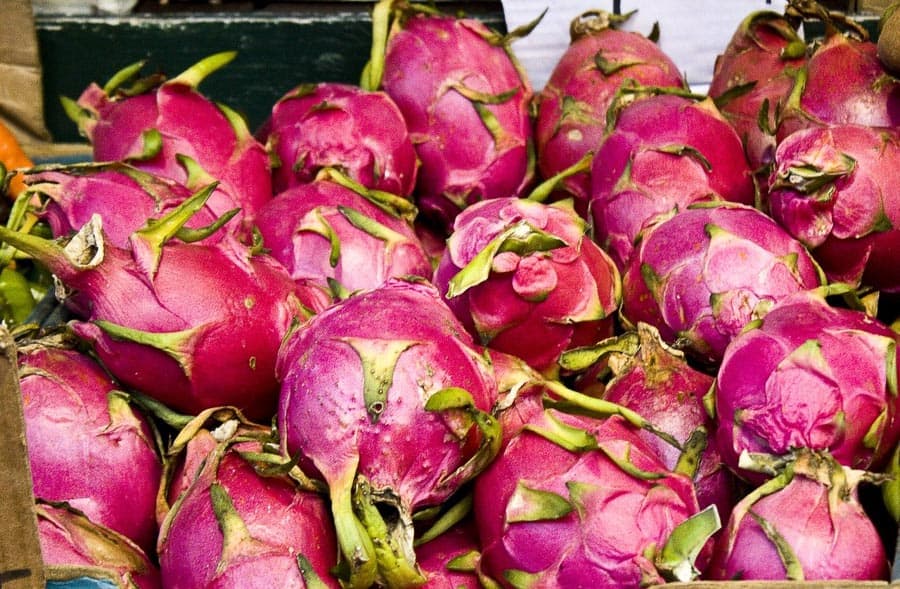
The flavour is mild and sweet. It also has a slight aroma. It can be eaten alone or added to smoothies or fruit salads. We have often come across dragon fruit in hotel buffets – mostly in Cambodia in Siem Reap. I think it is used more for its decorative effect than its flavor, but you can judge that for yourself.
D – Durian
Regarded as the “king of fruits” by many people in Southeast Asia, durian resembles jackfruit in almost everything including the thorny covered shell. It is large in size and possesses a strong odor. The fruit is large and reaches up to 3 kilos. Its flesh may be red or pale yellow, depending on the variety.

Durian typically have a sweet smell but to some, it is overpowering. Due to the persistence of this smell, the fruit has been banned from many food establishments in Southeast Asia. And many hotel lifts and corridors in Malaysia have signs banning Durians. You cannot take durian with you to the aeroplane.
Believe it or not, in Asia you can buy durian flavoured ice cream – they are truly disgusting. You can read about weird food in our other post.
F – Figs
The fig is technically an edible flower. They grow on a shrubby small tree with distinctive leaves which are known for their appearance in biblical paintings for covering the nakedness of Adam and Eve in the Garden of Eden.

Fresh figs from tropical markets are delicious to eat raw. They are soft and pink in the middle, sticky and sweet. They are also available dried which is the form we usually receive them in the West.
Dried figs, which are the treasury of bone-strengthening calcium. They have almost as much as a glass of milk! In addition, they are also the best source of fiber of any dried fruit. They also contain potassium-lowering potassium and magnesium that fights stress. Figs are also known for their medicinal use as a mild laxative.
We have figs growing in our garden in Muscat, Oman.
G – Goji Berry
Also known as wolfberry, the goji berry is native to China. It is distinctly bright orange-red, eggshaped about 2 centimeters in diameter. The fruit can contain up to 60 tiny yellow seeds firmly attached to the core.
Goji berries are usually dried, cooked before eating and they often supplement a rice congee.
Goji berries are fruits which healing properties have been used in natural medicine in Asian countries for over 2,500 years. they are used among others in the treatment of rheumatism and decrease in immunity. Goji berries are called the red diamonds of the East and belong to superfoods.
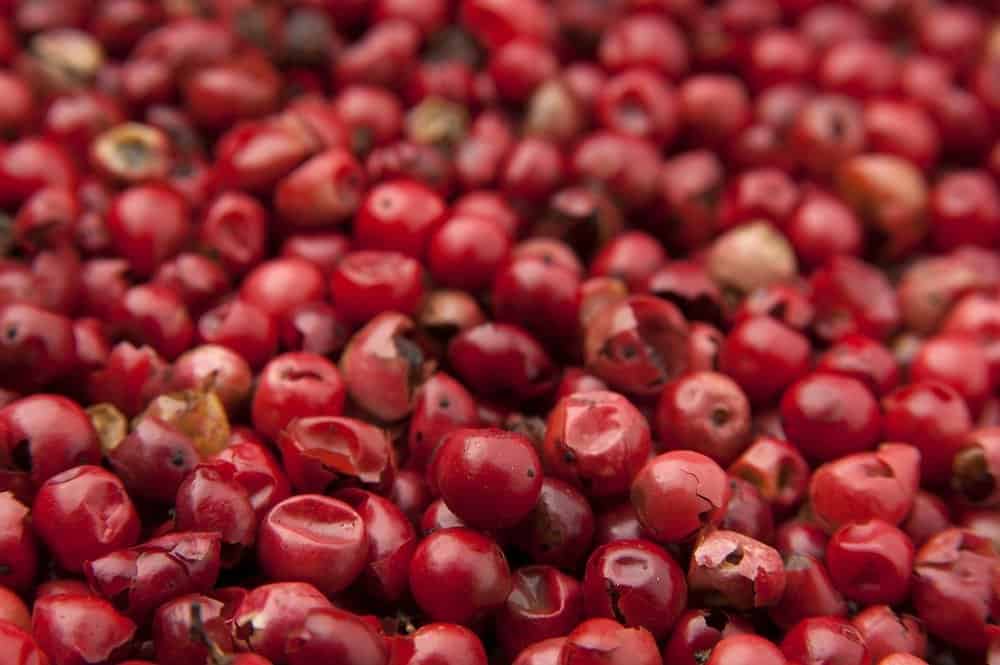
G – Guava
These are quite common fruits cultivated in many tropical and subtropical areas including South Asia. Depending on the variety, the outer skin may be rough and taste bitter or soft and taste sweet. Also depending on the variety, the flesh inside may be reddish or pale white, sweet or sour. The seeds are edible but hard.

Guava is usually eaten raw and can be cut into small pieces or eaten like an apple. In some countries, the fruit is eaten with a pinch of salt or pepper, cayenne powder or a mix of a variety of spices. In the West, guava are usually found blended into juices, so try the fruit itself while on your Asian travels
J – Jackfruit
Jackfruit is the largest tree borne fruit in the world, weighing up to 35 kilograms and 90 centimeters long and 50 centimeters wide. Its skin is green, rough, and hard. To eat a jackfruit, cut it into pieces (usually four quarters), and eat out its yellow and soft flesh. Despite how it looks like on the outside, the fruit is quite tasty and recognizable by its distinctive sweet fruity smell. The inside of the fruit smells like pineapple.
Jackfruit Native to the Indian Subcontinent and South East Asia. In Sri Lanka, we ate stew made from jackfruit. It was very tasty but heavy on the stomach. Jackfruit in Asia is often used as a meat substitute.
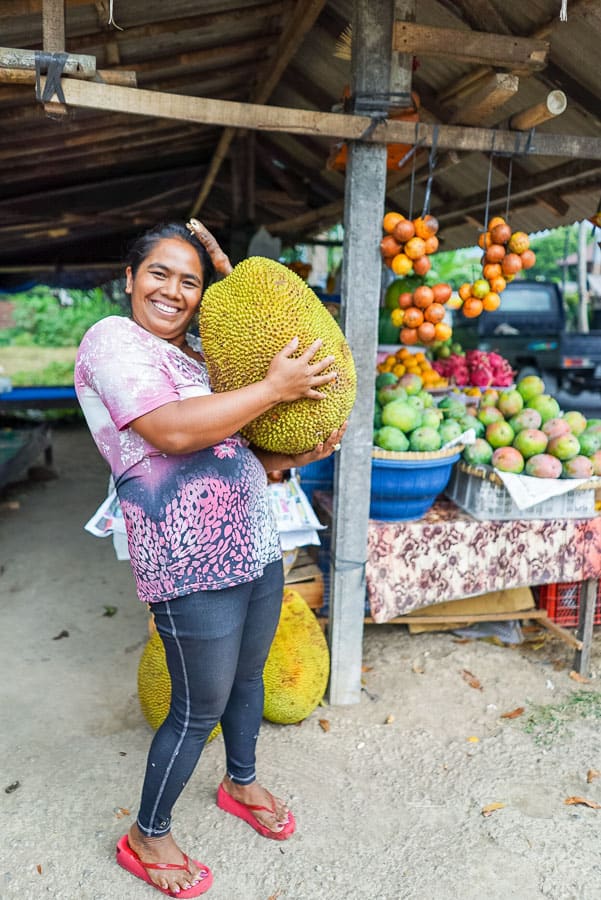
K – Kiwi Fruit
The name Kiwi was a marketing invention of the NewZealanders in the late twentieth century who were the first to cultivate the Chinese Gooseberry commercially. They were gathered wild in their native China at that time. It finds its place in this list because now at least 50% of world cultivation again now comes from China.
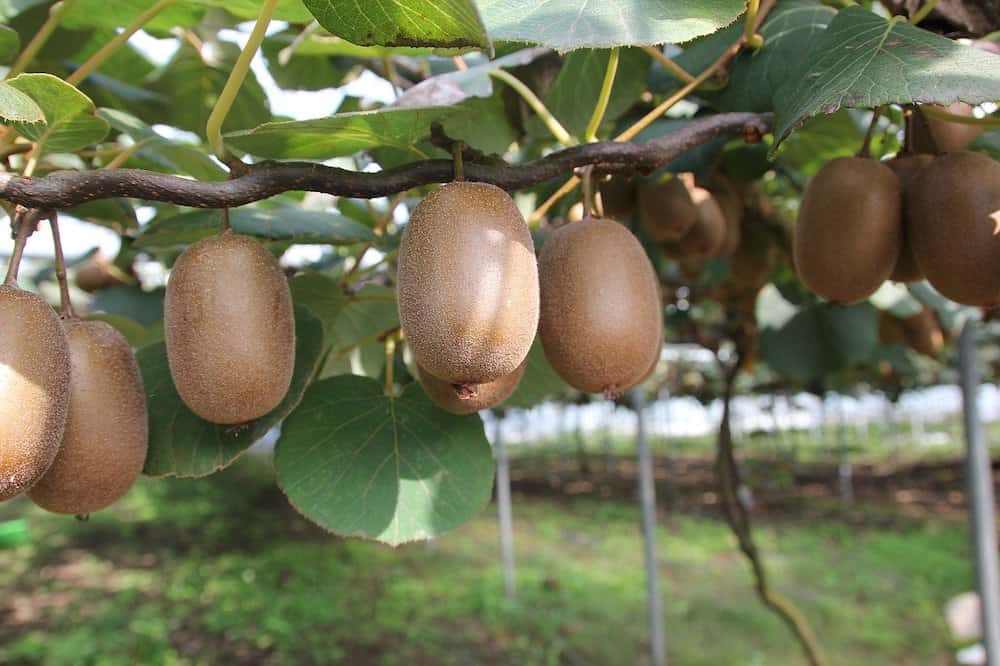
Kiwis grow on trailing vines, which can be trained over tunnel shaped frames making the gathering of fruit from inside the tunnel easy. The vines have large white flowers making this cultivation not only productive but beautiful.
The fruit is well known for its sharp tasting soft green pulp with small black edible seeds all contained in a khaki coloured slightly hairy suede skin. What is not commonly known is that the skin is also edible, and doesn’t have to be removed before juicing the fruit.
K – Kumquat
Kumquats are small fruits produced by the flowering plant from the Rutaceae family and are native to Southeast Asia as well as Asia Pacific zones. They resemble oranges but a bit smaller like a large olive. Kumquat can be eaten cooked, and due to its sour center, it is commonly used to make marmalades and jellies.
Kumquat is a natural dose of sugars, fiber and mineral salts. Like other citrus fruits, it contains large doses of vitamin C. Therefore, kumquat is recommended to strengthen immunity and reduce the risk of infection.
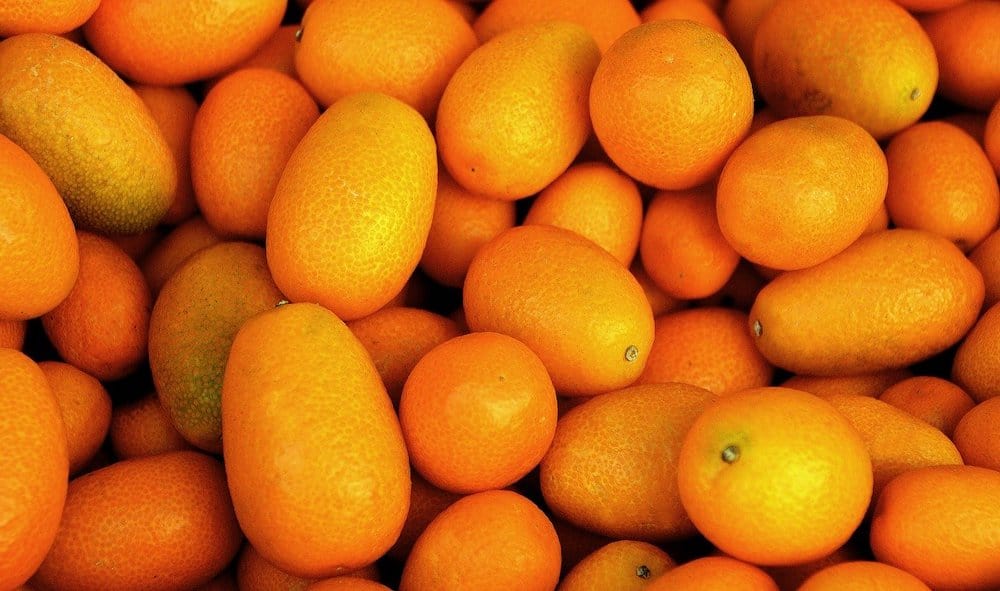
L – Langsat
Related to the central and South American mahogany tree, Langsat fruit is round, oval or elliptical, and resembles little potatoes. The fruits usually grow in clusters like grapes. A single fruit can contain up to 3 seeds covered with a thick, white aril.
The flesh of langsat is juicy and sweet and is packed with fructose, sucrose, and glucose. The fruits can be eaten raw or bottled into syrups.
The peel of the fruit can also be dried and in this form, it is used in Indonesia as incense to scare away mosquitoes and disinfect the air in rooms where sick people are present. The wood of the common sweetmeat is also used, which is durable and at the same time flexible and is used to make tools or masts.
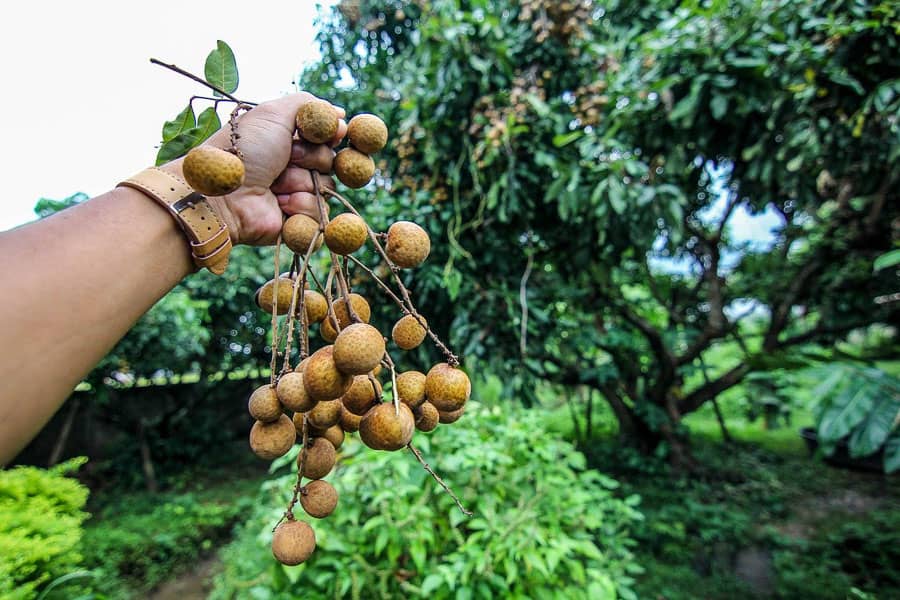
L – Lychee
A Chinese exotic fruit, lychee is pink-red fruit with a roughly textured rind that is inedible. The outer cover is easily removed, to access the flesh, which is usually sweet and translucent. Fresh lychee has a soft, whitish pulp with a floral fragrance.
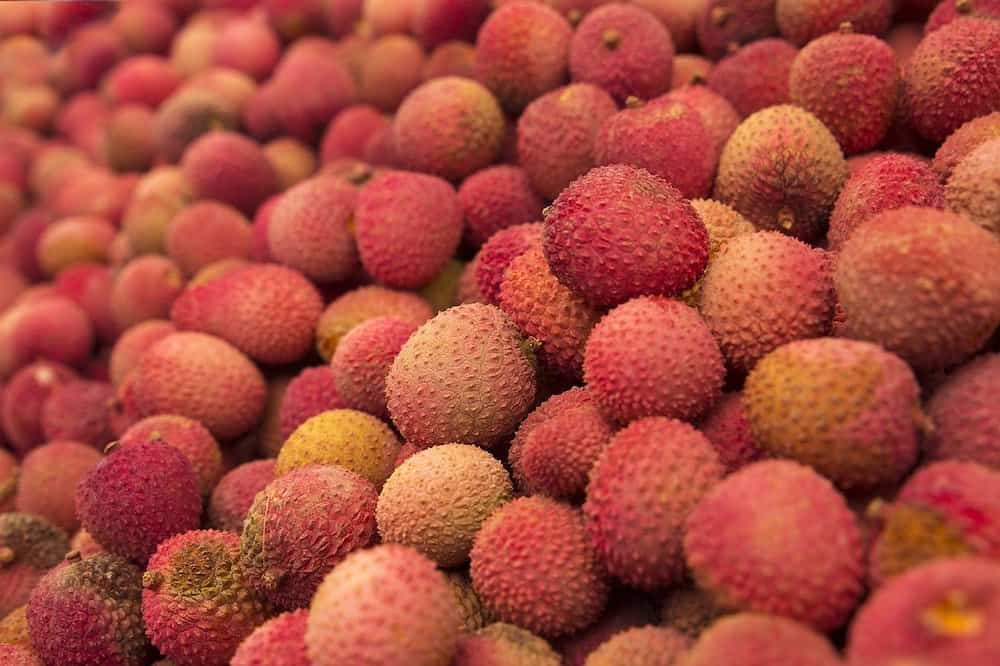
Researchers have proven that lychee has potential anti-cancer effects. It is also a rich source of vitamin C strengthening the body and potassium regulating blood pressure.
Lychee is best eaten fresh since canning loses its perfume-like flavor.
M – Mango
You have eaten mangoes before, right? If like us you are mystified by the wide variety in Asian supermarkets, try the Carabao. Said to be the sweetest mango in the world the Carabao originates from the Philippines, and is also known as the Manila Mango. We have eaten some delicious juice-dripping Indian mangoes too but have to acknowledge that the Guinness Book of World Records has listed the Carabao variety as the sweetest since 1995.
Mango is not only very tasty but also very healthy. the fruit contains a lot of potassium, thanks to which it lowers the high level of blood pressure
Eating mangoes every day can help lower blood sugar levels, even though it is high in sugar by itself.
Mango substances can inhibit the development of breast and colon cancer.
Mango is one of the tasties asian Fruits and it’s perfect to make vegan ice cream.
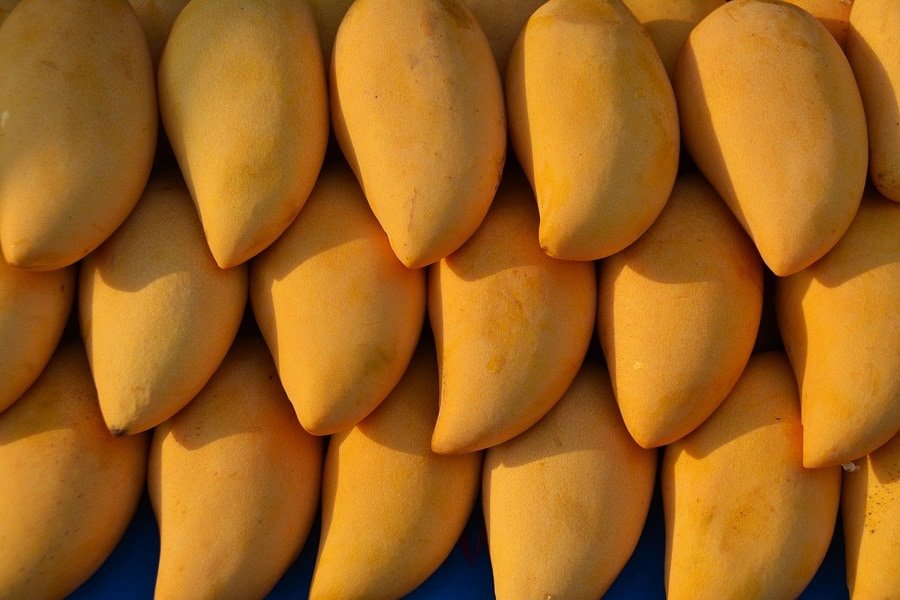
M – Mangosteen
Nothing like the mango, the Mangosteen is a small dull dark-burgundy coloured fruit containing several juicy white segments and one or more big seeds. Don’t eat the rind or the seed, but that tangy sweet white flesh is delicious. Mangosteen has been one of our family favourites since we first discovered them in Thailand when visiting Bangkok with kids.
The Mangosteen tree grows up to 25 meters tall. This evergreen tree grows mainly in South East Asia as well as in India and other tropical areas including Central America.
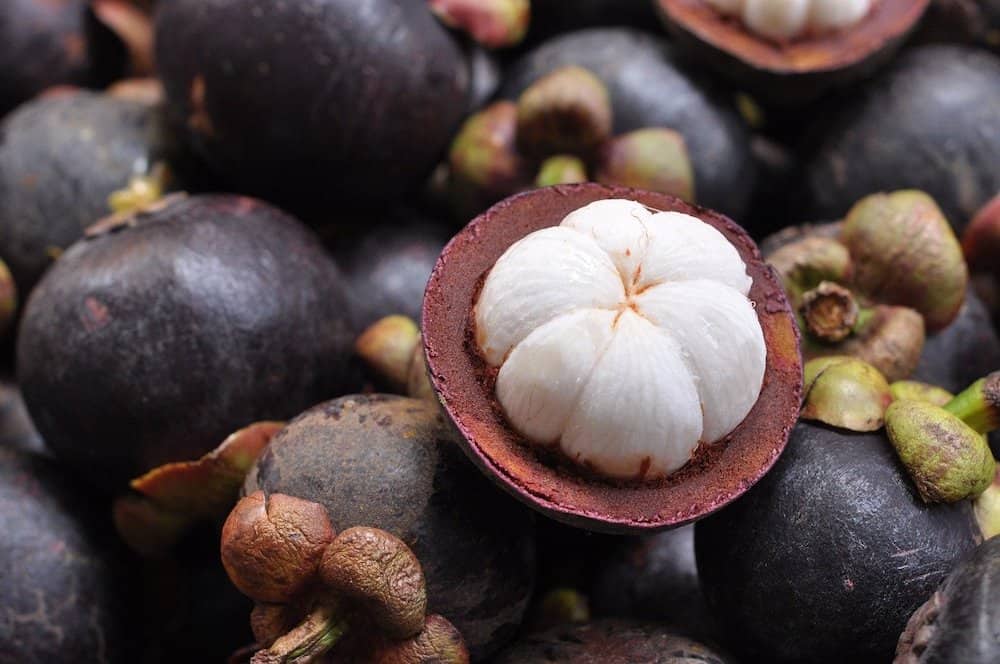
M – Meyer Lemon
Meyer lemons are native to China and are believed to be a cross between a lemon and a common orange or a mandarin. The fruit is yellow and round. The skin is thin and aromatic, and when ripe, the color turns to yellow with slight shades of pink.
Although yellow like a regular lemon, the Meyer’s variety resembles a lime in shape and size. When it comes to flavor, it has more sweetness and mildly acid.
N – Noni
Noni comes from Asian countries (Japan, China, Taiwan, Malaysia, Indochina). Its fantastic properties were first discovered by the inhabitants of Polynesia, who have been using it as a medicinal plant for centuries. s. Traditional Chinese medicine calls the Indian mulberry root – Ba Ji Tian. They were used mainly to fight abdominal pain, menstruation, and also to fight impotence.
Though visually unappealing, noni makes up for this with loads of health benefits. Noni juice helps protect against the effects of strokes, and has antioxidant, anti-bacterial, and anti-inflammatory properties too.
Indian mulberry contains many substances that are valuable to humans. Of the vitamins, we find primarily vitamin C and niacin (vitamin B3). In addition, fruits contain significant amounts of iron and potassium. However, mulberry owes its anti-cancer effect to a concentrated dose of a compound that is referred to as damnacanthal. It inhibits the chemical processes that turn a cell into a cancer cell.
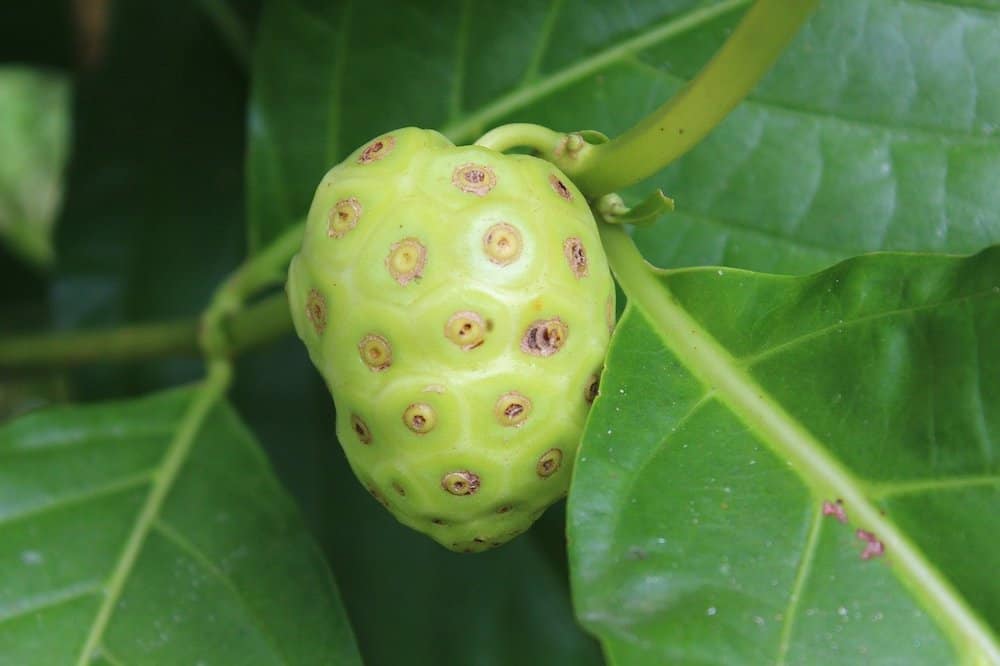
P – Papaya
A type of berry, Papaya is a common fruit that grows from a tree-like plant from three to ten meters tall, with spirally arranged leaves at the top of the trunk.
Papaya is soft when ripe with small black seeds at the centre. Ripe orange papaya taste best with lime juice, when the skin and seeds are removed. Unripe papaya is good for cooking, especially in stews and curries.
Papaya is appreciated not only for its taste, but also for its medicinal properties. It owes them mainly to carotenoids, which can prevent the development of cancer, and to papain – an enzyme that improves digestion.
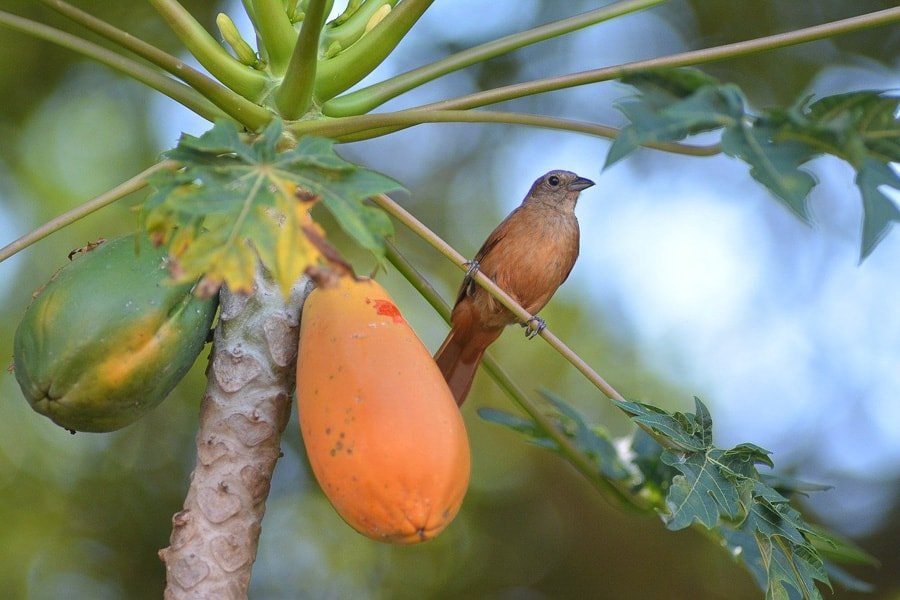
P – Passionfruit
Maracuja or Passionfruit is Nick’s favourite. It is a sweet, seedy tropical type of berry, with a hard case. Inside a soft white rubbery lining is a yellow juicy pulp filled with edible seeds. The pulp and seeds can be eaten raw or juiced. Passionfruit is often blended with other fruits to share its intense flavour and aroma.
How to eat the fruit ? Cut it in half and eat the inside with a spoon. Do not peel the peel, because the fruit has a too liquid and fragmented consistency.
Passion fruit helps fight even serious ailments from the nervous system. It nourishes the entire body, especially the skin. And with its great appearance and amazing smell and taste, passion fruit also nourishes our senses.
This exotic fruit is no only rich in B vitamins (vitamins B1, B2, B3, B6 and B9), passion fruit is also rich in vitamins – vitamin A, C, E and K, as well as mineral salts – zinc, phosphorus, magnesium, potassium, sodium, calcium and iron.
In natural medicine, passion fruit has long been used to treat various ailments of the nervous system. Eating passion fruit, in addition to improving our mental health, will also have a positive effect on the work of the heart, normalize pressure of the blood.
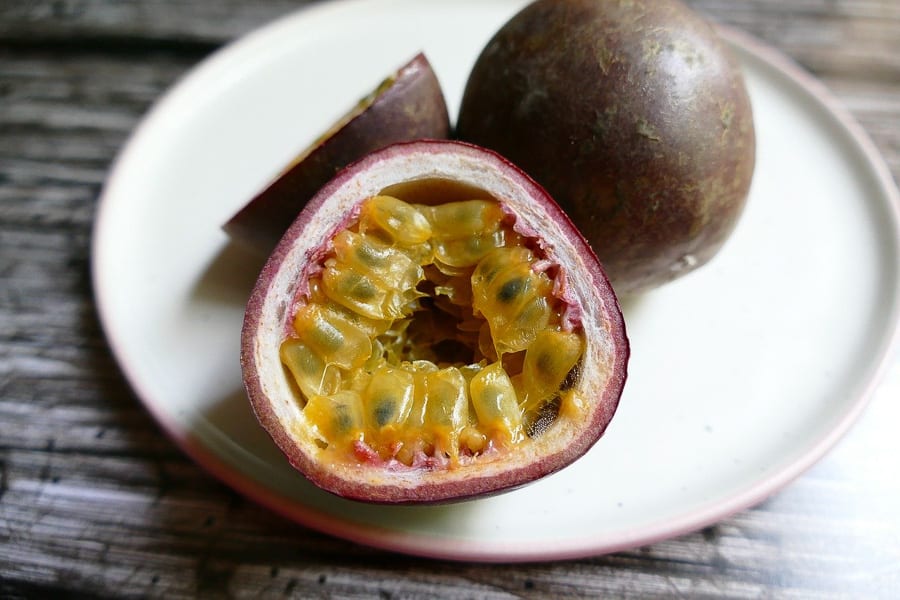
The fruit grows on a climbing plant which displays unique round intricate flowers and can be grown in temperate gardens as well as its native jungles.
P – Persimmon
The Persimmon is the national fruit of Japan and my personal favourite. I always look for persimmon wherever we go, so I can report that they are called by several names. I have found them labeled as Khaki (Middle East) Lotus (Greece) and Japan Apples (Montenegro) As well as being popular worldwide, persimmons are rich in minerals, vitamins, and tannin, which is associated with the health of body cells and the regulation of the flow of blood.
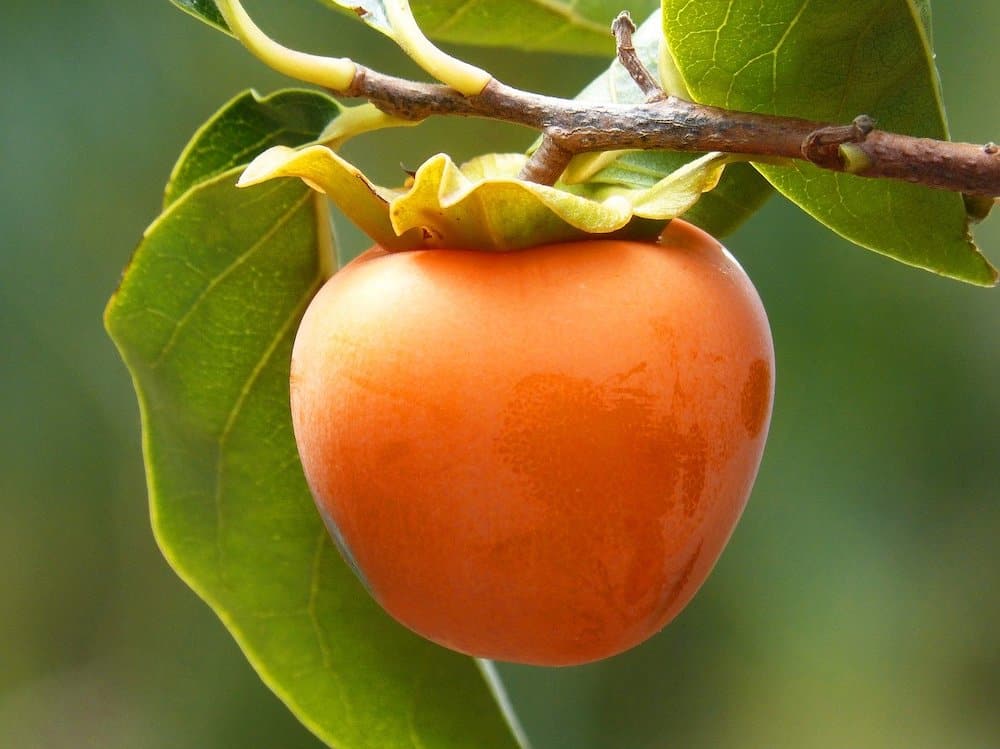
Persimmon is orange, smooth skinned and shiny, resembling something between an apple and a small pumpkin. You can eat the whole thing including the skin and the core. In Asia, it is used commonly for baking bread, and cookies, and also in various desserts including cake, pies.
P – Pomelo
Botanists believe that crossing a pomelo with a wild orange created a grapefruit. The fruit grows in tropical climates (it comes from Malaysia, Thailand, and is currently grown mainly in China and India) on trees that are even several meters high. It was brought to Europe by the British during the colonization.
The tree is thorny and very branched, and the fruit is produced all year round (it can bloom up to 4 times a year).
Pomelo is also a rich source of potassium a mineral element that is responsible for maintaining the body’s water and electrolyte balance and regulates muscle tone, blood pressure and heart rate.
Pomelo pectins contained in the flesh and skin also play an important role in the prevention of cardiovascular diseases, inhibiting the rate of fat deposition in the arteries and thus preventing the development of atherosclerosis. In turn, vitamin C helps to increase the elasticity of the vessels.
It is sweeter than grapefruit and has no bitterness. In China, pomelo is seen as the fruit of happiness.
When buying a pomelo, remember that the heavier it is, the fresher it is. The longer the fruit is transported and stored, the faster it dries out and loses weight. The best time for a pomelo is from November to March. When kept in the refrigerator, the fruit can last up to a week.
Pomelo can weight up to 2 kg, has quite this soft skin which is easy to peel.

R – Rambutan
Rambutan fruit is Malay-Indonesia native as well as other tropical regions in Southeast Asia. It is closely related to other Asian fruits including longan, lychee, and mamoncillo. The name is derived from the Malay-Indonesia term rambutan, which means “hair” in reference to the many hairy protrusions on the skin.
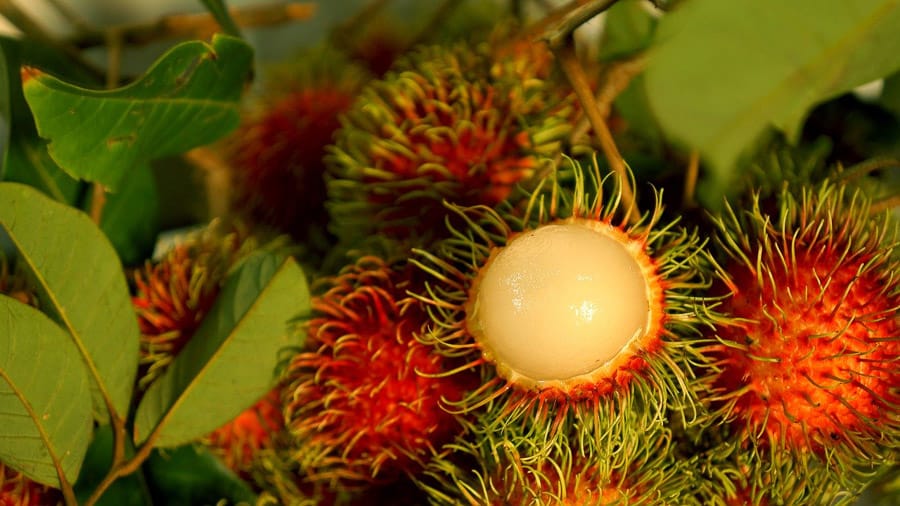
Rambutan flesh is translucent and whitish or pink with a sweet flavor, slightly acidic taste similar to mangosteen. It is another of our favourites.
S – Santol
Santol originates from the Philippines. It resembles an apple, but while an apple is sweet and succulent, santol has extremely sour taste. The seeds and young fruits can be canned and turned into marmalade or preservatives.
Santol roots can also be used in medicine, as a tonic or applied in a poultice to cure ringworm.
Due to its bitter taste, go easy on your first Santol tasting. Who knows – maybe it will become your new favourite? Or maybe not! At least not for me – far too bitter!!!
S – Sapodilla
Sapodilla is grown mainly in Malaysia, India, Cambodia, Thailand, Indonesia, and Bangladesh. Its appearance resembles a mixture of potatoes and kiwifruits and tastes like a pear. You know sapodilla is ripe if it has saggy skin and does not produce chicle when picked from its tree. The fruit contains up to six seeds, which are typically black and look like beans.
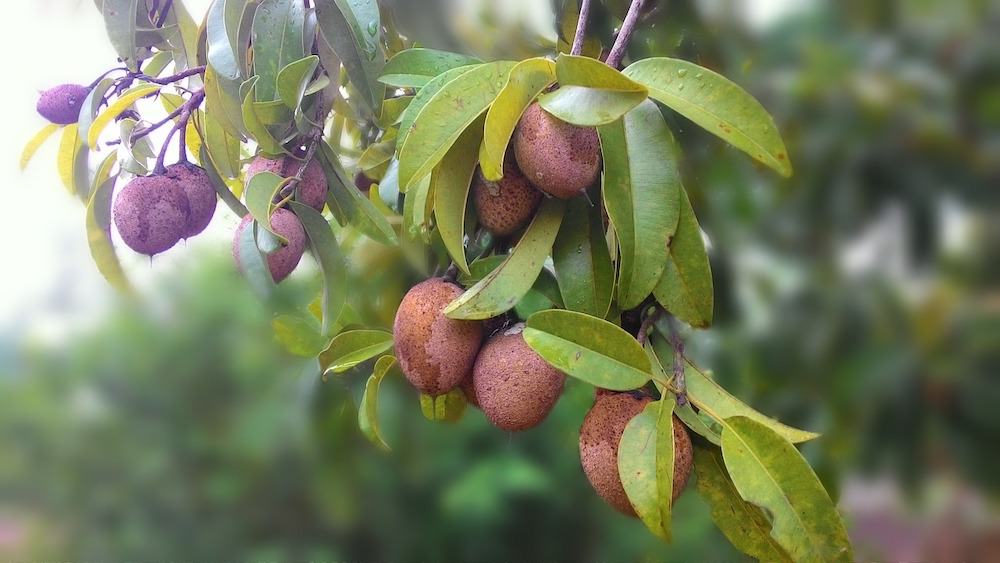
To eat this fruit, cut it into half and remove the seeds. The flesh can be eaten with a spoon.
S – Snake Fruit or Salak
This fruit comes from the islands of Sumatra and Java in Indonesia. The fruits typically grow in clusters at the bottom of the palm and it is named for the reddish-brown scaly skin. When it comes to size, Snake Fruit resembles a ripe fig but with a sharp tip.
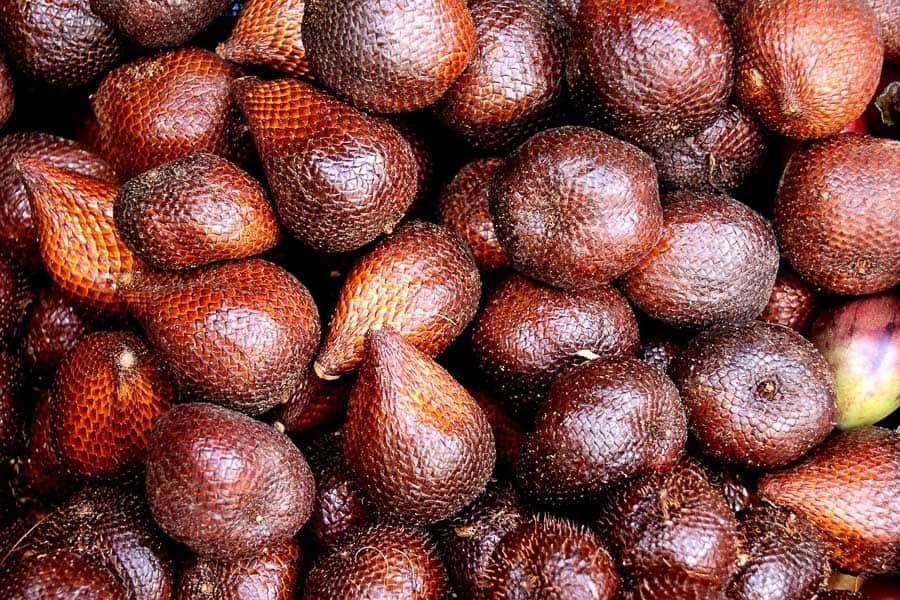
The pulp is edible, and you get at it by pinching the tip, causing the skin to slough off. Inside, there are three lobes each containing an inedible seed. Perhaps it is not just the skin which gives this fruit it’s name, because the flavour although sweet is sharp and astringent, reminiscent of garlic. Snake fruit can be eaten fresh or candied in syrup.
S – Soursop or Sirsak
Soursops are produced by the Annona muricata tree. The fruits are distinctively dark green and thorny. The interior is aromatic, succulent and sweet. Its taste like a mix of strawberry and pineapple with citrus. Soursop is commonly used as an alternative cancer treatment.
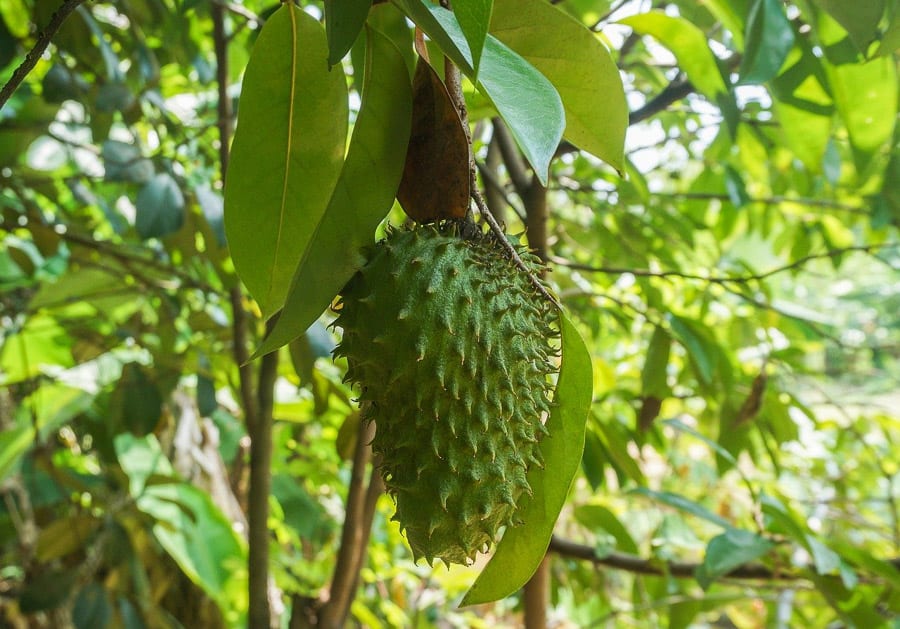
S – Starfruit or Carambola
Carambola has unique ridges that run down its sides so when cut through, the cross-sectional slices resemble a star. Its skin is thin, smooth, and waxy pale green to dark yellow when ripe. You can see them growing in orchards in Malaysia where the ripening fruits are often protected in bags before harvest.
Starfruit usually have a low sugar content (about 4%). And it has a distinct taste that is difficult to compare, but distinctively fruity. The Malaysians often sprinkle a little salt on the star-shaped slices.
Starfruit can also be cooked up for marmalades, and relishes, as well as juiced for fresh drinks.
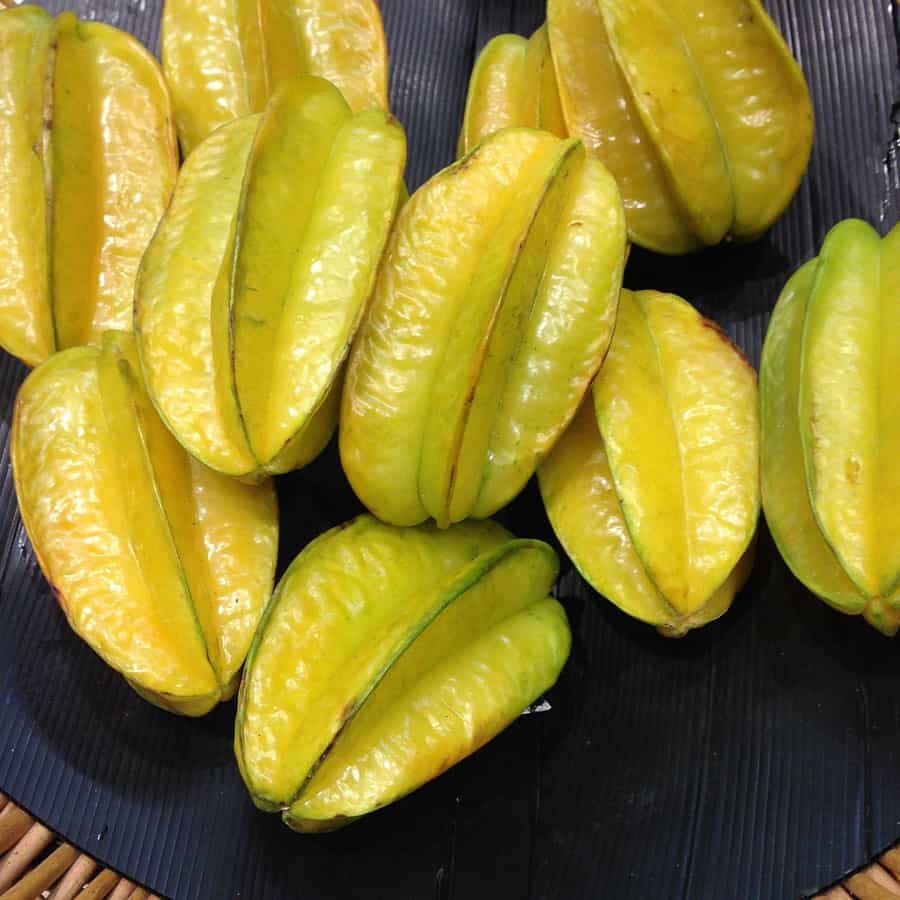
T – Tamarillo
Tamarillo is distinguished by an oblong, oval shape and smooth skin. In appearance, it is closest to a tomato – that is why it is called a fruit tomato or a tree tomato. Tamarillo comes from the same family as tomatoes, i.e. nightshades.
Tamarillo fruit is sweet and slightly sour at the same time. Not only does it look like a tomato, but the taste is also similar. The fruity note of tamarillo is similar to mango or passion fruit.
These egg-shaped fruits are usually yellow, orange, red or purple. Red tamarillos are more acidic, while orange and yellow fruits are sweeter. The flesh contains numerous seeds. Generally, tamarillos are packed with vitamins and iron content and they are low in calories.
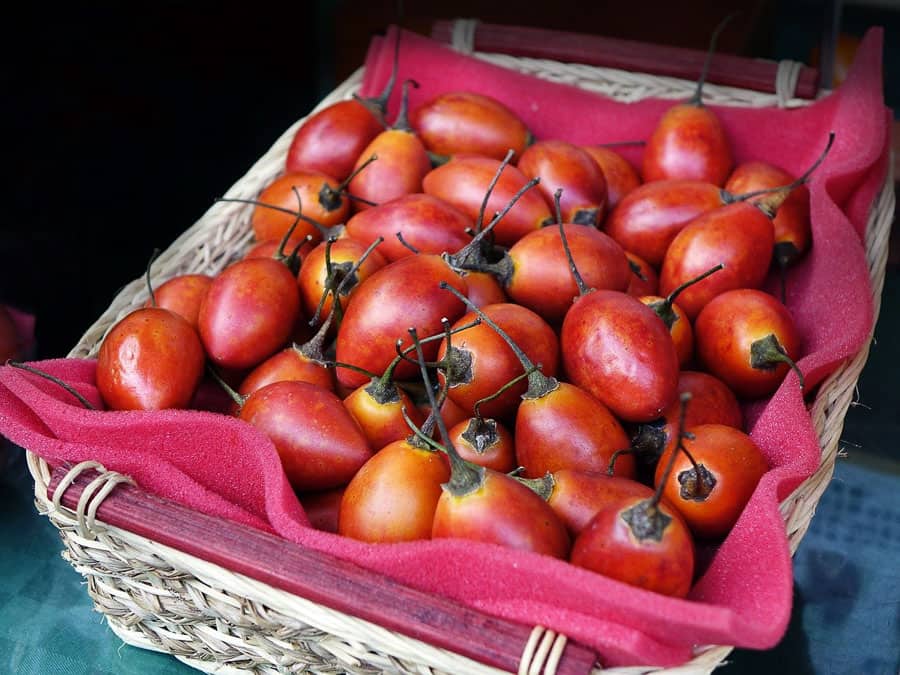
T – Tamarind
The bitter, pod-like tamarind fruit is used in cuisines around the world. The fruit is mature when it turns to brown or reddish-brown. The varieties that come from Asia are typically long and contain up to 12 seeds. Tamarind has sweet and sour taste and has a high content of tartaric acid, calcium, B vitamins, and sugar.
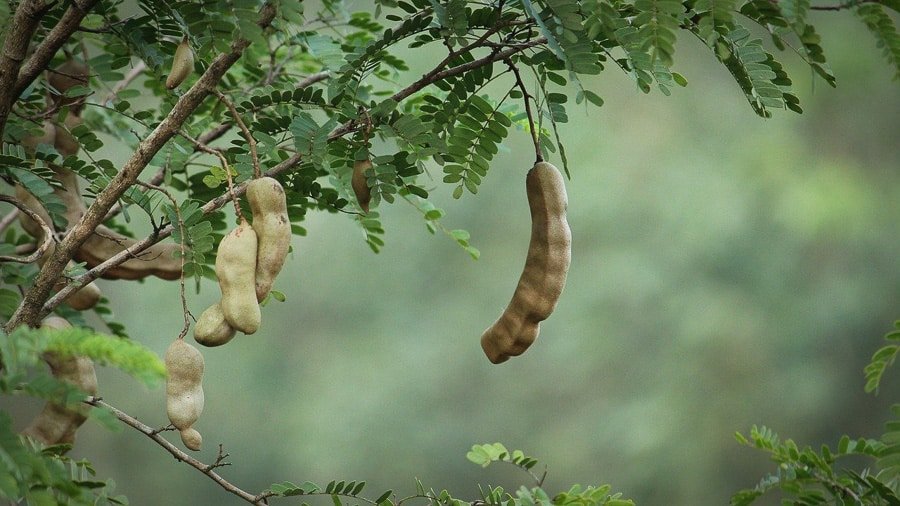
W – Watermelon
Watermelons are one of the most common fruits in the world and Southeast Asia. The fruit is recognizable by its smooth hard rind with green and dark green stripes or yellow dots. They are sweet and juicy and the flesh can be deep red, pink, orange-yellow, or white. The flesh also has seeds attached, which are edible.
Watermelon can be eaten raw, when they are best chilled. Alternatively the skin can be cooked.
W – Wood Apple
These are no ordinary apples. The smell can actually drive you away with its strong odor. However, if you can soldier past the smell, wood apples are delicious, especially when eaten raw, but can also mashed and turned into jam.
Wood apples have loads of health benefits too. Some of these include relieving indigestion, ulcers, and constipation.
Y – Yuzu
Yuzu was brought to Japan and Korea from China. It is a hybrid of sour mandarin and the Asian citrus Ichang papeda. It looks like the familiar mandarin – only the color is yellow. And the taste has a unique, tart – sour with a hint of flowers.
Yuzu contains three times more vitamin C than lemon. The fruit is rich in calcium and potassium. The fruit is rich in calcium and potassium. In Japanese culture, yuzu is valued as a natural means of protecting against infections – especially in winter.
Yuzu is usually not eaten raw but used for cooking. Its juice is typically used to create ponzu – a citrus marinade for fish or chicken.
Today, yuzu is widely cultivated in East Asia, as well as in the United States, where it is popular.
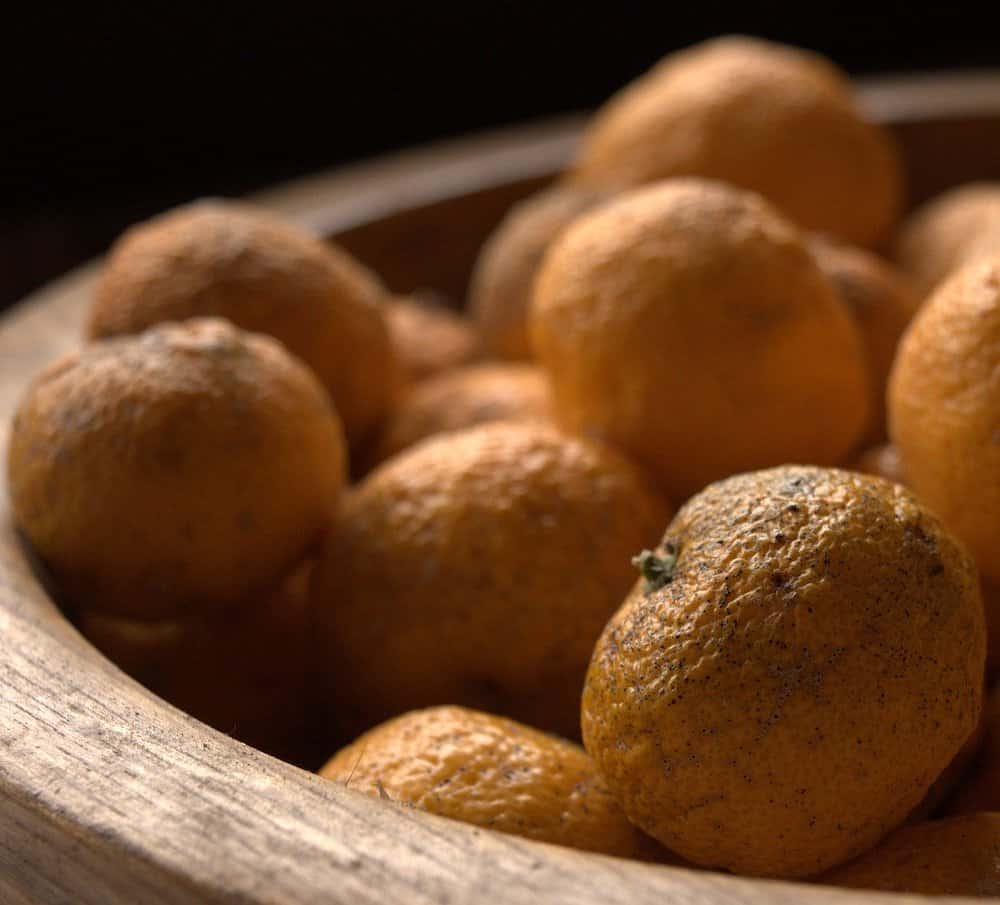
Asian Fruits – Conclusion
Some of these Asian fruits you can find no farther away than your local supermarket, others you may not find on even a long Asian tour; its a big continent! However I hope perhaps that my research will inspire you to share the fun I have had discovering and tasting some new flavours. Some of these have become my own family’s firm favourites.
Exotic Fruits from Asia – Pin it



